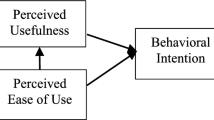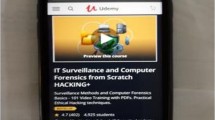Abstract
The aim of this study was to unveil the factors that affect the use of Mobile Cloud Learning (MCL) platform Blackboard. Considering the nature of MCL, the Unified Theory of Acceptance and Use of Technology (UTAUT) model was applied and modified with two additional variables, i.e. mobility and self-management learning to understand the use behaviour of the users. A survey was conducted through a structured questionnaire to collect quantitative data for analysis. Structural equation modelling (SEM) was used to analyse the data and test the hypotheses of this study. In outcome, performance expectancy, effort expectancy and self-management learning are found as significant factors. Blackboard platform provider and users’ can be benefited through the outcome of this study by looking at the significant factors and understanding the use behaviour of the users.

Similar content being viewed by others
Data availability
The datasets used and/or analysed during the current study are available from the corresponding author on reasonable request.
Abbreviations
- MCL:
-
Mobile Cloud Learning
- UTAUT:
-
Unified Theory of Acceptance and Use of Technology
- SEM:
-
Structural Equation Modelling
- PE:
-
Performance Expectancy
- EE:
-
effort expectancy
- SI:
-
Social Influence
- FC:
-
Facilitating Condition
- SML:
-
Self-Management Learning
- Mob:
-
Mobility
- BI:
-
Behavioural Intention
- UB:
-
Use Behaviour
- EFA:
-
Exploratory Factor Analysis
- CFA:
-
Confirmatory Factor Analysis
- CV:
-
Convergent Validity
- CR:
-
Composite reliability
- AVE:
-
Average Variance Extracted
- SPSS:
-
Statistical Package for the Social Sciences
- VLE:
-
Virtual Learning Environment
- LMS:
-
Learning Management System
- CMS:
-
Course Management System
- PLE:
-
Personal Learning Environment
References
Abar, B., & Loken, E. (2010). Self-regulated learning and self-directed study in a pre-college sample. Learning and Individual Differences, 20(1), 25–29.
Abu-Al-Aish, A., & Love, S. (2013). Factors influencing students’ acceptance of M-learning: An investigation in higher education. The Internation Review of Research in Open and Distance Lerning, 14(5), 83–107.
Ajzen, I. (1992). A comparison of the theory of planned behavior and the theory of reasoned action. Personality and Social Psychology Bulletin, 18, 3–9.
Al-Adwan, A., Al-Madadha, A., & Zvirzdinaite, Z. (2018). Modeling students’ readiness to adopt Mobile learning in higher education: An empirical study. The International Review of Research in Open and Distance Learning, 19(1), 221–241.
Al-Hunaiyyan, A., Alhajri, R. A., & Al-Sharhan, S. (2018). Perceptions and challenges of mobile learning in Kuwait. Journal of King Saud University – Computer and Information Sciences, 30, 279–289.
Austin, H. W. (1983). Sample size: How much is enough? Quality and Quantity, 17(3), 239–245.
Babakus, E., & Mangold, W. G. (1992). Adapting the SERVQUAL scale to hospital services: An empirical investigation. Health Services Research, 26(6), 767–786.
Bouranta, N., Chitiris, L., & Paravantis, J. (2009). The relationship between internal and external service quality. International Journal of Contemporary Hospitality Management 21(3), 21(3), 275–293.
Bradford, P., Porciello, M., Balkon, N., & Backus, D. (2007). The blackboard learning system. The Journal of Educational Technology Systems, 35, 301–314.
Bradley, J. (2009). Technology acceptance model and other user acceptance model. In Y. K. Dwivedi (Ed.), Handbook of research on contemporary theoretical models in information systems (illustrated ed., pp. 277–291). IGI Global.
Byrne, B. (2016). Structural equation modeling with AMOS. New York: Routledge.
Capterra. (2017). Capterra. Retrieved from https://www.capterra.com/learning-management-system-software/#infographic. Accessed 22 Feb 2018.
Carlsson, B. (2006). Internationalization of innovation systems: A survey of theliterature, 35 (2006) 56–67. Research Policy, 35, 56–67.
Carrillo, C. (2015). Quora. Retrieved from https://www.quora.com/Bb-What-are-the-advantages-and-disadvantages-of-blackboard-learning-system. Accessed 14 June 2018
Chandra, D. G., & Borah, M. D. (2012). Cost Benefit Analysis of Cloud Computing in Education. 2012 International Conference on Computing, Communication and Applications (pp. 1–6). IEEE Conferences.
Chaubey, A., & Bhattacharya, B. (2015). Learning management system in higher education. International Journal of Science Technology & Engineering- IJSTE, 2(3), 158–162.
Chen, X., Liu, J., Han, J., & Xu, H. (2010). Primary exploration of mobile learning mode under a cloud computing environment. 2010 International Conference on E-Health Networking, Digital Ecosystems and Technologies (EDT) (pp. 484-487). IEEE.
Cheon, J., Lee, S., Crooks, S. M., & Song, J. (2012). An investigation of mobile learning readiness in higher education based on the theory of planned behavior. Computers & Education, 59, 1054–1064.
Cheong, J. H., Park, M. C., & Hwang, J. H. (2004). Mobile payment adoption in Korea: Switching from credit card. Paper presented at the ITS 15th Biennial Conference. Berlin, Germany.
Chiu, C., & Wang, E. (2008). Understanding web-based learning continuance intention: The role of subjective task value. Information & Management, 45, 194–201.
Crompton, H. (2013). Mobile learning - new approach, new theory. In L. Berge & L. Y. Muilenburg (Eds.), Handbook of mobile learning (1st ed., pp. 47–57). New York: Routedge.
Dinh, H. T., Lee, C., Niyato, D., & Wang, P. (2011). A survey of mobile cloud computing: Architecture, applications, and approaches. Wireless Communications and Mobile Computing, 1587–1611.
Dwivedi, Y. (2009). Technology Acceptance model and other user acceptance model. In Y. K. Dwivedi (Ed.), Handbook of Research on Contemporary Theoretical Models in Information Systems (illustrated ed., pp. 277–291). IGI Global.
Falvo, D., & Johnson, B. F. (2007). He use of learning management systems in the United States. TechTrends, 51(2), 40–45.
Gaskin, J. (2016). Gaskination's StatWiki. Retrieved from http://statwiki.kolobkreations.com. Accessed 20 July 2018.
Gefen, D., Karahanna, E., & Straub, D. W. (2003). Trust and TAM in online shopping- an intregrated model. MIS Quaterly, 27(1), 51–90.
Georgiev, S., Georgieva, E., & Smrikarov, A. (2004). M-Learning – A New Stage Of ELearning. Proceedings Of The 5th Intern. Conference On Computer Systems And Technologies – Compsys Tech’2004. Rousse, Bulgaria.
Goh, T. (2009). Multiplatform E-Learning Systems and Technologies: Mobile Devices for Ubiquitous ICT-Based Education (illustrated ed.). IGI Global, 2009.
Gurung, R., Alsadoon, A., Prasad, P., & Elchouemi, A. (2016). Impacts of Mobile cloud learning (MCL) on blended flexible learning (BFL). The International Conference on Information and Digital Technologies 2016 (pp. 108–114). IEEE.
Hair, J., Black, W., Babin, B., & Anderson, R. (2010). Multivariate data analysis (7th ed.). Upper Saddle River: Prentice-Hall.
Harrison, D. A., Mykytyn, P. P., & Riemenschneider, C. K. (1997). Executive decisions about adoption of information technology in small business: Theory and empirical tests. Information Systems Research, 8 (2), 171–195.
Hinton, P., Brownlow, C., McMurray, I., & Cozens, B. (2004). SPSS explained. London: Routledge.
Hirsch, B., & Ng, J. W. (2011). Education beyond the cloud: Anytime-anywhere learning in a smart campus environment. . In Internet Technology and Secured Transactions (ICITST) 2011 International Conference. (pp. 718–723). IEEE.
idatalabs. (2017). idatalabs. Retrieved from https://idatalabs.com/tech/products/blackboard. Accessed 11 June 2018.
Isaila, N. (2014). Cloud computing in education. Knowledge Horizons. Economics, Bucharest, 6(2), 100–103.
Kaigin, B., & Basoglu, N. (2006). Adoption factors of Mobile services. International Conference on Mobile Business, (pp. 41–41). Copenhagen, Denmark.
Kaliisa, R., & Picard, M. (2017). A systematic review on Mobile learning in higher education: The African perspective. The Turkish Online Journal of Educational Technology (TOJET), 16(1).
Kronk, H. (2017). Elearning inside. Retrieved 07 21, 2018, from https://news.elearninginside.com/erasing-blackboard-canvas-mounting-learning-management-system-insurrection/. Accessed 21 July 2018.
Lai, C., Wang, Q., & Lei, J. (2012). What factors predict undergraduate students’ use of technology for learning? A case from Hong Kong. Computers & Education, 59, 569–579.
Lakshmi, & Dhanalakshmi, G. (2016). A review on Mobile cloud learning in higher education. International Journal of Engineering Research and Applications, 6(4), 32–38.
Li, J. (2010). Study on the development of mobile learning promoted by cloud computing. In IEEE 2010 2nd International Conference on Information Engineering and Computer Science (ICIECS), (pp. 1–4).
Liu, Y. (2008). An adoption model for mobile learning. IADIS International Conference e-Commerce (pp. 235–240). IADIS.
Loewenthal, K. M. (2004). An introduction to psychological tests and scales (2nd ed.). Hove: Psychology Press.
Lowenthal, J. (2010). Using Mobile learning: Determinates impacting behavioral intention. The American Journal of Distance Education, 24(4), 195–206.
Lu, J., Yao, J., & Yu, C. (2005). Personal innovativeness: Social influences and adoptionof wireless internet services via mobile technology. The Journal of Strategic Information Systems, 14(3), 245–268.
Malhotra, N. K., & Dash, S. (2011). Marketing research an applied orientation. London: Pearson Publishing.
Mallat, N., Rossi, M., Tuunainen, V., & Öörni, A. (2008). An empirical investigation of Mobile ticketing service adoption in public transportation. Personal and Ubiquitous Computing, 12(1), 57–65.
Martin, C. (2016). Flexmr. Retrieved from https://www.flexmr.net/blog/quantitative-research/2016/2/sample-size-calculator.aspx. Accessed 4 July 2018.
McFarlane, A., Roche, N., & Triggs, P. (2007). Mobile learning: Research findings-report to Becta. Bristol: Becta.
Mell, P., & Grance, T. (2009). NIST . Retrieved 03 11, 2018, from http://csrc.nist.gov/publications/nistpubs/800-145/SP800-145.pdf. Accessed 11 Mar 2018.
Nassuora, A. B. (2013). Students acceptance of mobile learning for higher in Saudi Arabia. International Journal of Learning Management System, 1(1), 1–9.
Ong, C., Laia, J., & Wan, Y. (2004). Factors affecting engineers’ acceptance of asynchronous e-learning systems in high-tech companies. Information & Management, 41, 795–804.
Palmer, R., & Dodson, L. (2011). Distance learning in the cloud: Using 3G enabled mobile computing to support rural medical education. Journal of the Research Center for Educational Technology, 7(1), 106–116.
Peters, K. (2007). m-learning: Positioning educators for a mobile, connected future. International Review of Research in Open and Distance Learning, 8(2), 1–17.
Prajapati, M., & Patel, J. (2014). The factors influencing in mobile learning adoption: A literature review. International Journal of Application or Innovation in Engineering and Management, 3(9), 133–138.
Revilla, M., Saris, W., & Krosnick, J. A. (2014). Choosing the number of categories in agree–disagree scales. Sociological Methods & Research, 43(1), 73–97.
Rimale, Z., Benlahmar, E., Tragha, A., & Guemmat, K. E. (2016). Survey on the use of the mobile learning based on mobile cloud computing. International Journal of Interactive Mobile Technologies (iJIM), 10(3), 35–41.
Roscoe, J. (1975). Fundamental research statistics for the behavioral sciences, (2, illustrated ed.). New York: Holt, Rinehart and Winston.
Saade, R., & Bahli, B. (2005). The impact of cognitive absorption on perceived usefulness and perceived ease of use in on-line learning: An extension of the technology acceptance model. Information & Management, 42, 317–327.
Sachdev, S. V., & Verma, H. V. (2004). Relative importance of service quality dimensions: A multisectoral study. Journal of Service Research, 4(1), 93–115.
Sagenmüller, I. (2016). U-Planner. Retrieved from https://www.u-planner.com/blog/advantages-and-disadvantages-of-cloud-computing-in-higher-education. Accessed 23 June 2018.
Saunders, M., Lewis, P., & Thornhill, A. (2015). Research methods for business students (7th ed.). England: Prentice Hall.
Sharlples, M. (2003). Disruptive devices: Mobile Technology for Conversational Learning. International Journal of Continuing Engineering Education and Lifelong Learning, 12(5), 504–520.
Sharples, M., Taylor, J., & Vavoula, G. (2007). A theory of learning for the mobile age. In R. Andrews & C. Haythornthwaite (Eds.), The SAGE handbook of E-learning research (pp. 221–247). London: SAGE.
Shorfuzzaman, M., & Alhussein, M. (2016). Modeling Learners’ Readiness to Adopt Mobile Learning: A Perspective from a GCC Higher Education Institution. Mobile Information Systems, 2016.
Smith, P., Murphy, K. L., & Mahoney, S. E. (2003). Towards identifying factors underlying readiness for online learning: An exploratory study. Distance Education, 24(1), 57–67.
Stantchev, V., Colomo-Palacios, R., Soto-Acosta, P., & Misra, S. (2014). Learning management systems and cloud file hosting services: A study on students’ acceptance. Computers in Human Behavior, 31, 612–619.
topuniversities. (2018). topuniversities (QS world Ranking). Retrieved from https://www.topuniversities.com/university-rankings/world-university-rankings/2018. Accessed 20 Nov 2018.
Venkatesh, V., & Davis, F. D. (2000). A theoretical extension of the technology acceptance model: Four longitudinal field studies. Management Science, 45(2), 186–204.
Venkatesh, V., Morris, M., Davis, G. B., & Davis, F. D. (2003). User acceptance of information technology: Toward a unified view. MIS Quarterly, 27(3), 425–478.
Venkatesh, V., Thong, J., & Xu, X. (2012). Consumer acceptance and use of information technology: Extending the unified theory of acceptance and use of technology. MIS Quarterly, 36(1), 157–178.
Verma, K., Dubey, S., & Rizvi, M. A. (2012). Mobile cloud a new vehicle for learning: m- learning its issues and challenges. International Journal of Science and Applied Information Technology, 1(3), 93–97.
Walker, R., Voce, J., Swift, E., Ahmed, J., Jenkins, M., & Vincent, P. (2016). 2016 Survey of Technology Enhanced Learning for higher education in the UK. University and Colleges Information System Association (UCISA). UCISA.
Wang, X., & Wang, J. (2018). Oreilly. Retrieved 07 21, 2018, from https://www.oreilly.com/library/view/structural-equation-modeling/9781118356302/c07anchor-1.html. Accessed 21 July 2018.
Wang, Y., Wu, M., & Wang, H. (2009). Investigating the determinants and age and gender differences in the acceptance of mobile learning. British Journal of Educational Technology, 40(1), 92–118.
Wang, M., Chen, Y., & Khan, M. J. (2014). Mobile cloud learning for higher education: A case study of Moodle in the cloud. The International Review of Reserach in Open and Distance Learning, 15(2), 254–267.
Wright, K. B. (2017). Researching internet-based populations: Advantages and disadvantages of online survey research, online questionnaire authoring software packages, and web survey services. Journal of Computer-Mediated Communication, 10(3).
Wu, H., & Chang, Y. S. (2016). Using cloud-based mobile learning for practice-oriented education. Journal of the Chinese Institute of Engineers, 39(6), 755–764.
Wu, Y. L., Tao, Y., & Yang, P. C. (2007). Using UTAUT to explore the behavior of 3G mobile communication users. 2007 IEEE International Conference on Industrial Engineering and Engineering Management, (pp. 199–203). Singapore.
Yi, M., Jackson, J., Park, J., & Probst, J. (2006). Understanding informationtechnology acceptance by individual professionals: Toward an integrativeview. Infromation and Mangement, 43(3), 350–363.
Zhou, T., Lu, Y., & Wang, B. (2010). Integrating TTF and UTAUT to explain mobile banking user adoption. Computers in Human Behavior, 26, 760–767.
Author information
Authors and Affiliations
Corresponding author
Ethics declarations
Competing interests
Not Applicable.
Additional information
Publisher’s note
Springer Nature remains neutral with regard to jurisdictional claims in published maps and institutional affiliations.
Rights and permissions
About this article
Cite this article
Sultana, J. Determining the factors that affect the uses of Mobile Cloud Learning (MCL) platform Blackboard- a modification of the UTAUT model. Educ Inf Technol 25, 223–238 (2020). https://doi.org/10.1007/s10639-019-09969-1
Received:
Accepted:
Published:
Issue Date:
DOI: https://doi.org/10.1007/s10639-019-09969-1




